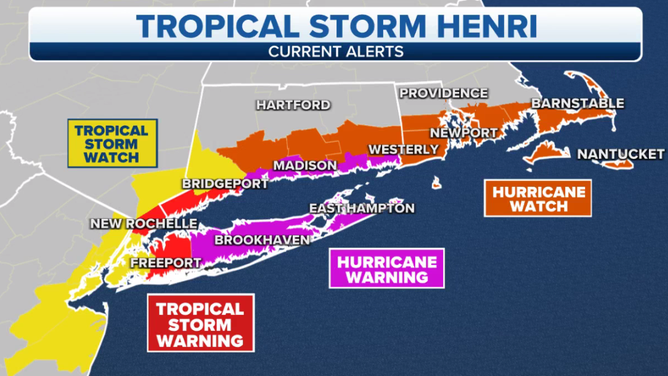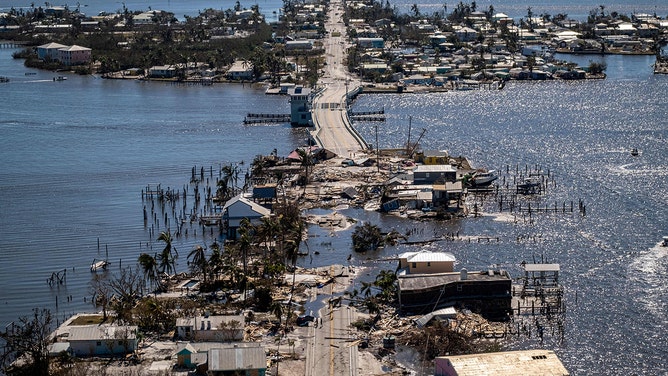Hurricane, Tropical Storm Watch vs. Warning: Why it’s important to know the difference
Warnings are more dire than watches, but even watches need to be taken seriously. Warnings mean the storm is imminent, so all preparations should be rushed to completion when a warning is issued for your town.
Hurricane, Tropical Storm Watch vs Warning
Tropical Storm Watches vs Tropical Storm Warnings
When a hurricane or tropical storm develops in the Atlantic or Eastern Pacific Ocean, meteorologists at the National Hurricane Center issue a variety of products, including watches and warnings, to keep the public informed about the dangers faced along the tropical storm’s projected track.
The primary goal of any NHC product is to protect life and property, so it’s important to understand what it means when a Hurricane or Tropical Storm Watch or Warning is issued for your town.

NOT A CURRENT MAP – An example of the watches and warnings issued by the National Hurricane Center during Henri in August 2021.
The NHC issues advisories every six hours for all active Atlantic and Eastern Pacific tropical cyclones. These updates always occur at 5 a.m., 11 a.m., 5 p.m. and 11 p.m. Eastern daylight time. But in the case that watches and warnings are in effect for any land areas, the NHC provides additional updates at the three-hour intervals between those times, which might include new watches or warnings.
WHAT TO DO WHEN HURRICANE OR TROPICAL STORM WATCHES AND WARNINGS ARE ISSUED FOR YOUR TOWN
Watches do not mean these disaster conditions will definitely occur; they only mean those dangerous conditions are possible, but you still need to take Tropical Storm Watches seriously.
The difference between Tropical Storm and Hurricane Warnings vs. Watches is that warnings are more dire than watches because they mean the storm is imminent, so all preparations should be rushed to completion when a warning is issued for your town.
What is a Tropical Storm Watch?
Tropical Storm Watch: Tropical-storm-force winds (sustained winds of 39 to 73 mph) are possible within the storm watch area, generally within 48 hours. These winds may be accompanied by storm surge, coastal flooding and/or river flooding.
What is a Hurricane Watch?
Hurricane Watch: Hurricane-force high winds (sustained winds of 74 mph or greater) are possible within the watch area, generally within 48 hours. These winds may be accompanied by storm surge, coastal flooding and/or river flooding.
What is a Storm Surge Watch?
Storm Surge Watch: There is a possibility of life-threatening inundation from rising water moving inland from the shoreline somewhere within the watch area, generally within 48 hours.

An aerial picture taken on September 30, 2022 shows the only access to the Matlacha neighborhood destroyed in the aftermath of Hurricane Ian in Fort Myers, Florida.
(RICARDO ARDUENGO/AFP / Getty Images)
What is a Tropical Storm Warning?
Tropical Storm Warning: Tropical-storm-force winds are expected within the storm warning area within 36 hours. These winds may be accompanied by storm surge, coastal flooding and/or river flooding.
What is a Hurricane Warning?
Hurricane Warning: Hurricane-force winds are expected somewhere within the emergency warning area. The National Hurricane Center issues Hurricane Warnings 36 hours before the most likely arrival of tropical-storm-force winds to give you time to complete your preparations. These winds may be accompanied by storm surge, coastal flooding and/or river flooding. Hurricane Warnings can remain in effect when dangerously high water, or a combination of dangerously high water and exceptionally high waves, continues, even though winds may be less than hurricane force.
KNOW YOUR ZONE: EVACUATION MAP SHOWS WHO NEEDS TO EVACUATE FOR A HURRICANE
What is a Storm Surge Warning?
Storm Surge Warning: There is a danger of life-threatening inundation from rising water moving inland from the shoreline somewhere within the warning area, generally within 36 hours.
What is an Extreme Wind Warning?
Extreme Wind Warning: Extreme sustained winds of major-hurricane force (115 mph or greater), usually associated with the eyewall, are expected to begin within one hour. Take immediate shelter in the interior portion of a well-built structure to secure safety.
The FOX Weather app is free to download and will notify you of any weather alerts issued for your current and saved locations.
